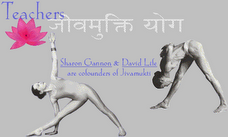We know yoga was highly developed by the Indian civilization, but Sharon told us there is evidence of yoga existing even before then; evidence has been found of yoga-type influences in the Egyptian mystery schools. Who really knows; what we do know, though, is what yoga has become for us now in modern day. And it is a fairly complex picture, isn't it?! Although there are already TONS of types of yoga advertised out there, yoga can actually be categorized into more than just the physical hatha yoga practice known best by the West. Going back to the "tools" discovered by the ancient sages, there are four basic types of yoga which use these tools differently.
1. HEART - Bhakti Yoga
This yoga uses emotions and directs them towards devotion for the Divine. In this way, they develop an intense personal relationship with God characteristic of a human relationship. The "bhakta" perceives the world through his heart and embraces fully all emotions because they all lead to God. As yogis, we intuitively understand the importance of the heart, but science is only now slowly catching up. Some scientists are now labeling the heart as an organ of perception equal to the brain. Bhaktas have known this all along, and have shared their experiences with us through the ages. Here are some examples of bhaktas (who have come to us from all religions):
 Neem Karoli Baba, and his devotees to include Ram Das, Shyam Das, Bhagavan Das, Krishna Das, Durga Das, and many many others
Neem Karoli Baba, and his devotees to include Ram Das, Shyam Das, Bhagavan Das, Krishna Das, Durga Das, and many many others"Everything is impermanent, except the Love of God" --Neem Karoli Baba
 Rumi whose love for God found its expression in an outpouring of music, dance and lyric poems
Rumi whose love for God found its expression in an outpouring of music, dance and lyric poems"Love’s nationality is separate from all other religions,
The lover’s religion and nationality is the Beloved (God).
The lover’s cause is separate from all other causes
Love is the astrolabe of God’s mysteries." --Rumi
2. HANDS - Karma Yoga
This yoga focuses on the perfection of action through the performance of selfless service. The secret to service, though, is performing the acts with absolutely no expectation of personal benefit but fully as an offering to God.
 Mother Theresa saw everyone she served, the most destitute and desperate people of India, as Christ incarnate and selflessly devoted herself to them.
Mother Theresa saw everyone she served, the most destitute and desperate people of India, as Christ incarnate and selflessly devoted herself to them."I am a little pencil in the hand of a writing God who is sending a love letter to the world." --Mother Theresa
3. MIND - Jnana Yoga
This yoga uses the faculty of the intellect, the rational mind to understand the mind. The principle method of this type of yoga is the practice of self-inquiry, constantly analyzing and questioning "who am I?"In this way, the yogi strips away who they are not, and keeps negating their identity until they get to their essential Being. Methods include study of scripture, meditation, and other scholarly focuses.
 Shri Ramana Maharishi whose primary teachings are documented in the book Nan Yar (Who am I), and which involve fixing the attention firmly and intensely on the feeling of 'I', without thinking.
Shri Ramana Maharishi whose primary teachings are documented in the book Nan Yar (Who am I), and which involve fixing the attention firmly and intensely on the feeling of 'I', without thinking.
"Since all the living beings desire to be happy always, without any misery..., it is necessary to know oneself. For that, enquiry in the form 'Who am I' alone is the principal means." --Shri Ramana Maharishi
4. MIND - Raja Yoga
The yoga most known in the West derives from Raja Yoga, or the Kingly path. This type of yoga was systematized by Patanjali in the Yoga Sutras, and is a method that has refined the meaning of mind to be "Consciousness" rather than intellect, as in jnana yoga. Widely known is his 8-step plan, or the 8-limbs of yoga. However, in his infinite compassion, he also gave three other methods in the sutras......something I didn't know until Sharon and David explained it to us. So, in total, he gives four methods of attaining enlightenment through consciousness:
- 1-step method: bhakti yoga through ishwara pranidanad va (surrender to the Divine)
- 2-step method: abhyasa and vairagya (practice and nonattachment)
- 3-step method: tapas (discipline), svadhyaya (self-study), and ishwara pranidanad va (surrender to the Divine)
- 8-step method: yamas, niyamas, asana, pranayama, pratyahara, dharana, dhyana, and samadhi
Jivamukti as a form of Integral Yoga
So, not until recently, all these yogas were separate. However, a holy being named Sri Aurobindo came along and wanted to create a new approach which combines all four yogas, naming it "Integral Yoga." Two of his students eventually came to the United States and brought to us this combined approach, leading to the yoga we have now. Swami Sivananda came and named his style Sivananda Yoga, and Swami Satchidananda came and his teachings came to be called Integral Yoga.
So, Sharon and David explained to us that they developed the Jivamutki Yoga Method to follow in this tradition of Sri Aurobindo's Integral Yoga. Jivamukti, in this way, also encompasses elements from all four types of yoga.

















No comments:
Post a Comment